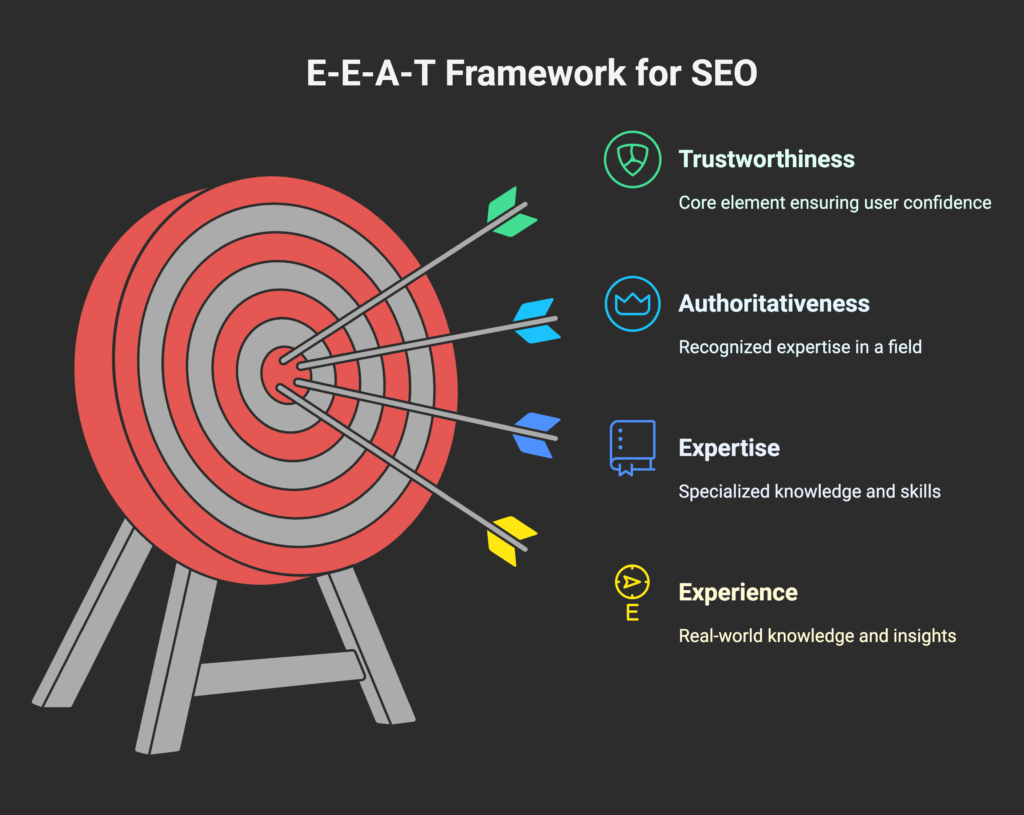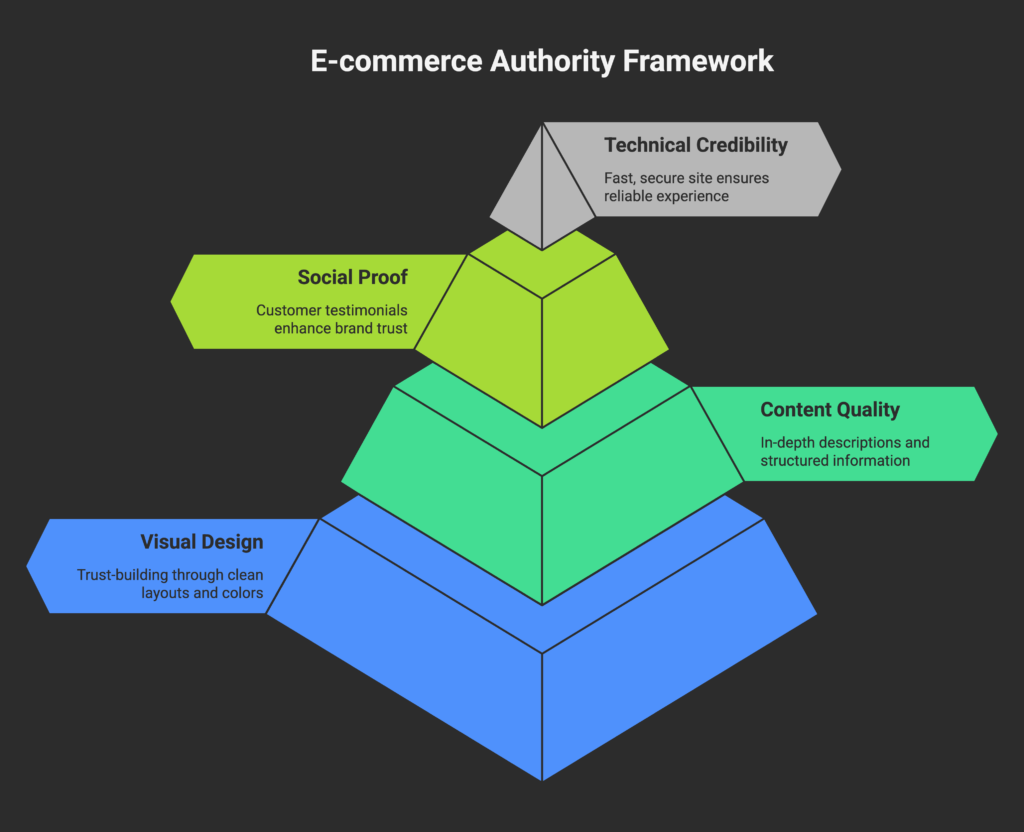Have you ever wondered why some online stores instantly look trustworthy, while others make you pause? Ever clicked away from a website because it didn’t feel “credible enough?” You’re not alone. When you finish reading this article, you’ll know exactly how to build a sense of authority that makes shoppers feel confident about hitting that “Buy Now” button. Ready to discover the secrets behind e-commerce credibility? Let’s jump right in!
Definition and Scope of Authority in Online Retail
Authority in e-commerce is all about being recognized as a credible source in your industry. It combines trust and credibility so that people feel safe doing business with you. Historically, authority was built through face-to-face interactions—like a shopkeeper who knew every customer by name. Now, with the digital shift, we must prove our reliability through design, content, and user experience. This is also tied to Cialdini’s principle of authority, which says we’re more likely to trust figures or businesses that appear knowledgeable or influential.
The Business Value of Authority
Strong authority often translates to higher conversion rates. Statistics show that when customers see you as an expert, they buy more frequently and spend more money per purchase. Plus, having an authoritative position sets you apart in a competitive world. Think about it: Why compete on price alone when you can compete by being the most trusted voice in your space? By emphasizing credibility, you also boost average order value and secure better customer loyalty. Conversely, if your credibility is weak, you risk losing sales and facing higher costs in acquiring new customers.
Overview of E-E-A-T Framework

The E-E-A-T framework stands for Experience, Expertise, Authoritativeness, and Trustworthiness. It’s a significant factor Google looks at when ranking websites, including e-commerce stores. This framework first appeared as E-A-T, but “Experience” was added to highlight how real-world knowledge adds to credibility. If your online store deals with “Your Money Your Life” (YMYL) topics—like health or finance—E-E-A-T becomes even more crucial. Showing your real-world know-how, specialized background, and commitment to user trust is vital in today’s search landscape.
Great! Now you know why authority matters and how it’s measured. But what actually happens in our minds when we trust an online store? Let’s find out in the next section.
The Psychological Foundations of Authority
Curious about why your brain sometimes instantly decides to trust a website? This section explores the mental processes that shape our decisions. By the end, you’ll realize how authority nudges us to click “Buy” without much second-guessing.
Cognitive Mechanisms Behind Authority Perception
When we’re unsure, we look for shortcuts. Heuristics—those quick mental rules—help us pick a seemingly safe option. Authority is one such shortcut. According to the concept of System 1 vs. System 2 thinking, System 1 is fast and intuitive, while System 2 is slower and more analytical. In e-commerce, System 1 often wins out, meaning if your website looks and feels authoritative, shoppers are likelier to trust you quickly.
Trust Formation in Digital Environments
In a physical store, you can talk face-to-face with sales staff and see product quality in real-time. Online, that personal element is missing. So you have to bridge the trust gap through signals like clear communication, professional design, and reliable reviews. Trust is built on three pillars: ability (you know what you’re doing), benevolence (you care about the customer), and integrity (you keep your promises). If any of these pillars is shaky, customers will click away.
Neuroscience of Authority and Credibility
Brain studies show that credible imagery—like confident language or official badges—lights up parts of our brain associated with reward and reduced anxiety. That means when people see clear authority signals, they subconsciously feel safer. Emotional responses blend with rational checks, making authority a powerful force that can quickly change buying decisions.
We’ve explored how trust is formed in the mind. Let’s now shift gears and look at the core elements that help you stand out as an e-commerce authority.
Core Components of E-commerce Authority
Ready to uncover the building blocks that scream “credible and trustworthy”? In this section, you’ll see how design, content, social proof, and technical aspects all come together to create a powerful authority presence.

Visual and Design Elements
A professional look isn’t just about aesthetics—it’s about trust. Clean layouts, easy navigation, and well-structured categories make shoppers feel you’re a serious business. Color psychology also plays a role. Certain colors can make people feel calm and confident, while disorganized color schemes might signal chaos. Fonts also matter: overly fancy typefaces can reduce readability, while a clean typeface reflects clarity and authority. Finally, use visual hierarchy so the most important messages or credentials stand out first.
Content Quality and Information Architecture
Your words shape how expert you seem. In-depth product descriptions, how-to articles, and blog posts that actually answer customer questions show you genuinely know your stuff. A well-structured information architecture (like easily searchable categories and subcategories) further boosts authority. Aim for a blend of depth (detailed insights) and breadth (cover multiple topics), so visitors see that you’re both knowledgeable and versatile.
Social Proof and Collective Validation
Social proof ties closely to authority. When prospective buyers see testimonials, reviews, or user-generated content, they automatically assume, “People trust this brand, so I can too.” Encourage customers to leave honest reviews and highlight these across your site. Even negative reviews, when handled respectfully, show you are authentic and willing to learn.
Technical Credibility Factors
A slow or unsecured site can hurt your credibility. Site performance (fast loading speeds) reassures visitors you’re prepared to serve them efficiently. Display security badges, HTTPS protocol, and robust backend infrastructure to indicate stability. Also, ensure a seamless experience across mobile, tablet, and desktop to maintain consistent authority signals.
So far, we’ve covered the core pieces of authority. Next, let’s explore the ways to showcase your expertise in a way that makes shoppers think, “These folks know what they’re talking about!”
Building Authority Through Expertise Demonstration
Earning the trust of your audience means showing them how knowledgeable you are. This section will help you spotlight your know-how in ways that convert curious browsers into loyal customers.
Thought Leadership Development
If you want to be seen as an expert, publish content that shares insights from your industry. Write blog posts, produce articles with original research, or speak at events (in-person or virtually) to demonstrate your authority. When people see your thoughtful commentary, they’ll connect your brand with expertise.
Product Knowledge Showcasing
Whether you sell electronics, fashion, or fitness gear, you need to highlight detailed product knowledge. Create comparison tables, buying guides, and even short videos that show how to use your products effectively. Depth of information reassures potential buyers that they are dealing with a genuine pro.
Customer Education Strategies
Teach your customers, and they’ll trust you more. Offer guides, tutorials, and webinars that solve real-life problems. For instance, if you sell kitchen gadgets, post recipes or cooking hacks. This not only boosts authority but also makes your site more interactive and engaging. Post-purchase content can even reduce return rates, because people know how to use the products correctly.
Technical Authority Establishment
If you have certifications or specialized training, showcase them on your site. People love knowing your team has real credentials or partnerships with reputable organizations. If you serve a specific niche, highlight how your specialized focus makes you the “go-to expert.”
Now you have the tools to show off your expertise. But expertise alone isn’t enough. Let’s move on to trust signals that reinforce your authority even further.
Trust Signals and Authority Indicators
Authority and trust go hand in hand. You’ve seen how content and credentials matter, but how do you visually communicate trust? In this section, we’ll discuss badges, reviews, transparency, and storytelling to amplify credibility.
Visual Trust Badges and Certifications
Badges from payment processors or industry bodies instantly assure shoppers they’re in good hands. Security seals (like SSL certificates) signal safe transactions. Balance is key—too many badges can clutter your design, but the right mix of prominent, well-placed badges can reinforce your professional image.
Customer Reviews and Testimonial Systems
An effective review system is like digital gold. Whether you gather star ratings, written feedback, or even video testimonials, displaying authentic reviews at the right points (like product pages or pop-ups) helps new visitors feel at ease. Don’t shy away from occasional less-than-perfect reviews; addressing them honestly can further boost trust.
Transparent Business Practices
Honesty is a big driver of trust. Make policies easy to find and explain them clearly. Be upfront about pricing, shipping costs, and return conditions. Overpromising but underdelivering erodes your authority. Instead, set fair expectations and follow through.
Brand Story and Authentic Narrative
Show your human side. Introduce your founder, share why your brand started, and highlight your mission. A relatable brand story makes your business more approachable and fosters an emotional bond. Keep a consistent voice and message across social media, emails, and your website.
You’ve added trust signals to your store. Next, let’s see how to spread these authority elements throughout the entire customer journey.
Authority Implementation Across the Customer Journey
Building authority isn’t just about having a great homepage or product page. It needs to be woven into every step of the buying experience. Let’s explore how to infuse credibility from the first click to long after the purchase is complete.
Pre-Purchase Authority Building
Start strong by making a fantastic first impression on your landing pages. Use ads or marketing materials that mention awards, media coverage, or expert opinions. Offer educational content—like comparison guides or top tips—early in the awareness phase. If buyers see you as trustworthy before they even explore your products, half your job is done.
Authority During Purchase Decision
Once they’re on your product page, reinforce trust with badges, clear specs, and an uncluttered design. Offer helpful recommendations that show genuine expertise. If someone abandons their cart, a follow-up message highlighting product features or credibility points can nudge them back.
Post-Purchase Authority Reinforcement
After checkout, keep the trust flowing with clear delivery updates and user-friendly confirmation emails. Encourage product feedback or tutorials in follow-up emails. The unboxing experience is another chance to surprise and delight—throw in a small thank-you note or helpful tips to keep the positive vibe going.
Long-term Authority Cultivation
Authority is never “done.” Keep communicating with your buyers, offer them new educational content, and invite them to communities where they can interact with like-minded customers. As markets change, stay current with updated credentials, partnerships, or training. Authority grows when you keep proving you’re the real deal.
Now that you’ve mapped authority across the journey, let’s look at how to measure the impact of all these efforts.
Measuring Authority and Credibility Impact
Ready to see if your hard work is paying off? This section will cover the metrics and testing approaches that help you track authority-driven results, from conversions to loyalty.
Key Performance Indicators
Authority can be measured through conversion rate improvements, but also via heatmap data (are people hovering over your trust badges?), feedback surveys, and repeat purchase rates. If your lifetime value is climbing, that’s a clear sign of deeper trust.
A/B Testing Authority Elements
Want to know whether a new badge design or a testimonial block is making a difference? Try A/B testing. Run experiments where half your visitors see the new version and the other half see the original. Check metrics like click-through rates, add-to-cart rates, and final conversion to see if your changes really help.
Competitive Authority Assessment
Periodically benchmark against top players in your niche. See how they display credentials, handle social proof, or structure product information. Look for gaps in their authority strategy—those gaps might be your golden opportunity to shine even brighter.
Armed with measurement strategies, you can refine your approach. Next, let’s zoom in on specific industries to see how authority tactics might differ.
Industry-Specific Authority Strategies
Not all e-commerce stores face the same hurdles. Selling a high-end watch isn’t the same as selling a quick snack. In this section, we’ll break down how different industries can adapt authority strategies to match their audience and product type.
High-Consideration Purchases
Luxury items or expensive tech require longer decision cycles. Shoppers compare options, read reviews, and might even seek expert opinions. In these cases, you need detailed content, top-notch visuals, and possibly personal consultation services. Build authority by highlighting premium certifications, exclusive brand stories, and white-glove customer support.
Fast-Moving Consumer Goods (FMCG)
For products like snacks or toiletries, speed and convenience often matter more than deep research. Authority here means immediate brand recognition and quick trust signals. Make your site load fast, use strong branding, and highlight quick shipping or easy returns. This way, buyers can confidently make quick decisions.
Technical and Specialized Products
When your audience is tech-savvy or looking for very detailed specifications, you need to prove you know the finer details. Show off your product’s specs in a way that’s easy to compare. Provide advanced FAQs and a robust support system that can handle complex questions. Your specialized knowledge is what sets you apart.
Service-Based E-commerce
If you sell services—like marketing solutions or online classes—your authority rests on showcasing credentials, client stories, and case studies. Let potential customers see real examples of your success. And keep nurturing existing clients with ongoing support or tips to maintain that expert reputation.
Now that you know how authority adjusts to different industries, let’s check out common pitfalls and challenges you should watch out for on your journey.
Common Authority Pitfalls and Challenges
Every great strategy has its stumbling blocks. In this section, you’ll learn about typical obstacles that can undermine your credibility and how to avoid or fix them.
Overcoming Initial Trust Barriers
If you’re a new brand, establishing authority from scratch can be tough. Partner with credible influencers or experts to “borrow” their trust. Offer generous guarantees or transparent return policies to show you have nothing to hide. Building trust can be a step-by-step process, so celebrate small wins like a few positive reviews.
Authority Maintenance During Growth
As your store expands, it might be harder to keep consistent service levels. More products can mean more complexity. Make sure your support team, website structure, and branding remain aligned with the quality you promise. Customers should feel they get the same “caring expert” vibe, even if you’re becoming a larger company.
Recovering from Trust Breaches
Mistakes happen—maybe a product batch had defects or shipping got delayed. The key is transparent communication. Acknowledge the issue, fix it quickly, and update your audience on the steps you’re taking. A sincere apology, plus a clear plan to prevent future issues, can help rebuild trust.
Balancing Automation and Human Touch
Automation can streamline tasks, but be careful not to lose your personal touch. Chatbots and AI are handy, but customers often appreciate a real human for complex queries. Make it easy to switch from bot to human, and ensure your automated messages still reflect a warm, expert tone.
By anticipating these pitfalls, you can keep your authority intact even when challenges arise. Next, let’s see what the future holds for e-commerce authority—because trends evolve fast!
Future Trends in E-commerce Authority
E-commerce never stands still, and how we establish authority continues to shift. In this section, discover the emerging signals, technologies, and best practices that will shape tomorrow’s online credibility.
Evolving Authority Signals
Consumers are quick to adopt new trust indicators—things like blockchain verification or augmented reality demos. Stay open to showcasing real-time proof of authenticity or specialized badges that didn’t even exist a few years ago. The point is to remain flexible and update your authority signals as buyer expectations change.
AI and Authority Building
Artificial intelligence can help personalize your store experience and offer relevant content to each user. This feels authoritative when done right, because it shows you “understand” what customers want. AI can also evaluate user behavior to predict what sorts of trust signals might resonate most, but be sure to keep it transparent so customers don’t feel manipulated.
Cross-Platform Authority Consistency
From social media to marketplaces like Amazon, your brand presence needs to feel consistent. If you appear highly trustworthy on your website but unpolished on another channel, potential buyers might get confused. Align your visuals, voice, and trust signals wherever you have a digital footprint.
Ethical Considerations in Authority Marketing
While authority can boost sales, it shouldn’t be used to manipulate. Be careful about cultural differences—what works in one region might look pushy in another. Always base your claims on real expertise. True authority is built on honesty and genuine knowledge, not gimmicks.
So, the future looks bright for those ready to adapt. Let’s bring it all together with final insights to guide your strategy long-term.
Conclusion: Strategic Authority Development
We’ve explored the ins and outs of e-commerce authority, from its psychological roots to real-world applications. You’ve learned how design, content, social proof, and consistent user experiences all unite to make your store the go-to choice.
Key Takeaways for Implementation
- Focus on Design: Professional layouts and clear visuals build immediate trust.
- Provide Expert Content: Depth and clarity in product descriptions, guides, and blogs.
- Show Real Proof: Testimonials, certifications, and transparent reviews.
- Stay Consistent: Make sure every channel reflects the same authority signals.
Long-term Authority Strategy
Authority isn’t a one-time job; it grows as you earn more customer trust and deepen your expertise. Stay aware of market trends, keep updating your certifications, and never forget that genuine helpfulness fosters loyal, long-term customers.
Looking to boost your Shopify store even further? Don’t forget about Growth Suite. This handy app helps optimize sales funnels and customer engagement, giving your business the extra push it needs to turn authority into revenue.
Don’t forget to check Building Trust & Authority in E-commerce: The Credibility Blueprint guide.
References
- WiserNotify. (2024, September 26). The Authority Principle’s Impact on Consumer Behavior. https://wisernotify.com/marketing-term/authority-principle/
- ValueSelling. (2025, February 18). How to Leverage Authority Marketing. https://www.valueselling.com/podcasts/how-to-leverage-authority-marketing
- Exnoweb. (2025, February 19). Applying Cialdini’s Principles to E-Commerce Design. https://exnoweb.com/blog/applying-cialdinis-principles-to-e-commerce-design/
- The Brand Hopper. (2025, February 15). How E-Commerce Platforms Build Trust and Credibility with Customers. https://thebrandhopper.com/2025/02/15/how-e-commerce-platforms-build-trust-and-credibility-with-customers/
- e:command. (2024, June 29). Building Trust and Credibility in E-commerce for Success. https://ecommand.co.uk/building-trust-and-credibility-in-e-commerce-for-success/
- MageWorx. (2023, March 17). Brand Credibility: How to Increase Trust in eCommerce. https://www.mageworx.com/blog/trust-indicators-in-ecommerce
- SE Ranking. (2025, February 11). Ecommerce Trust: How to build it right. https://seranking.com/blog/ecommerce-trust-factors/
- Koç, T., & Çevik, F. (2022). Building Trust in E-Commerce: A Practical Trust Guide for Evaluation. Alphanumeric Journal, 10(2). https://dergipark.org.tr/tr/download/article-file/2497093
- Datrycs. (2025, January 31). Psychological triggers that supercharge eCommerce sales. https://www.datrycs.com/blog/psychological-triggers-that-supercharge-ecommerce-sales
- Remark. (2025, February 19). How To Build Credibility for Your Ecommerce Store. https://www.withremark.com/blog/how-to-build-credibility-for-your-ecommerce-store
- MarketerHire. (2025, January 1). Authority Marketing. https://marketerhire.com/glossaries/authority-marketing
- Practical Ecommerce. (2024, May 2). Robert Cialdini on Social Commerce. https://www.practicalecommerce.com/robert-cialdini-on-social-commerce
- SEO.AI. (2024, December 2). 30 Tips on How to Build Trust in Ecommerce (2025). https://seo.ai/blog/how-to-build-trust-in-ecommerce
- FasterCapital. (2024, June 2). Online trust and credibility for e commerce. https://fastercapital.com/content/Online-trust-and-credibility-for-e-commerce–Establishing-Credibility-in-the-Online-Marketplace.html
- Ranktracker. (2025, January 28). E-E-A-T for Ecommerce Stores: Building Trust and Authority. https://www.ranktracker.com/blog/e-e-a-t-for-ecommerce-stores/
- Jadil et al. (2024, August 30). Managing consumer trust in e-commerce: evidence from advanced and emerging markets. International Journal of Retail & Distribution Management. https://www.emerald.com/insight/content/doi/10.1108/ijrdm-10-2023-0609/full/html
- Easy Digital Downloads. (2024, May 8). How to Use Consumer Psychology in eCommerce to Drive Sales. https://easydigitaldownloads.com/blog/how-to-use-consumer-psychology-in-ecommerce/
- Dropshipping.com. (2024, September 4). Ecom Authority Reviews: Is It Legit or Scam? Unveiling the Truth. https://dropshipping.com/article/ecom-authority-reviews/
- Search Engine Journal. (2018, October 24). How Ecommerce Websites Can Achieve E-A-T Quality. https://www.searchenginejournal.com/ecommerce-websites-expertise-authority-trust/273111/
- Cialdini, R. B. (2007). Influence: The Psychology of Persuasion. Collins Business.





[…] The Science of Authority: Building Credibility in Your E-commerce Store Social Proof 2.0: Beyond Reviews to Real-Time Social Signals Trust Signals: The Complete Hierarchy from Basic to Advanced […]